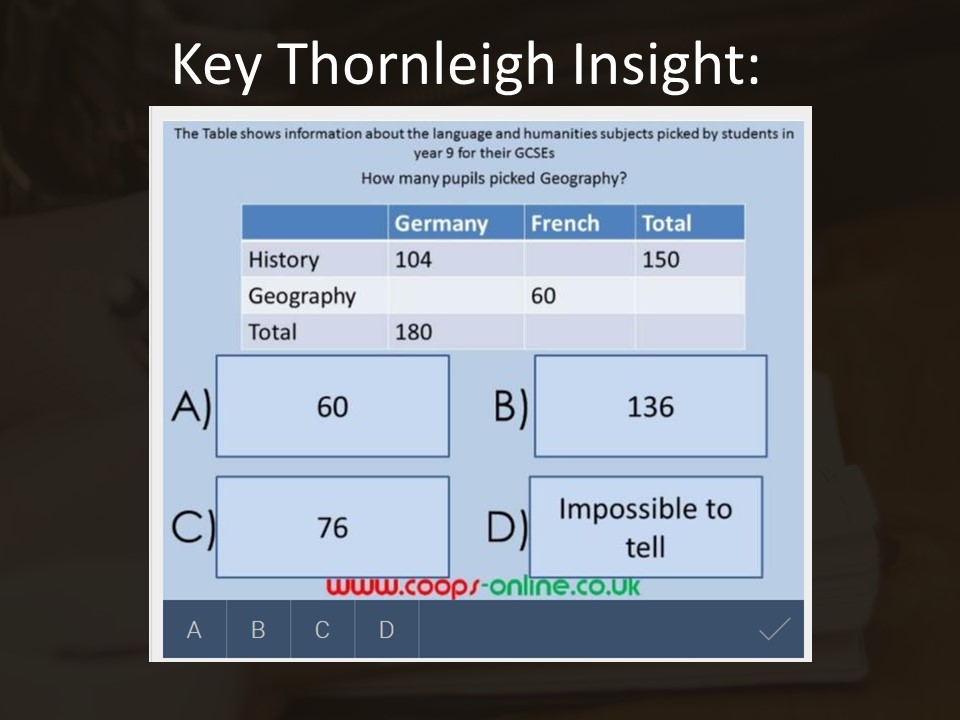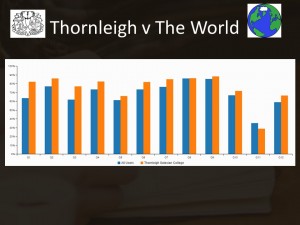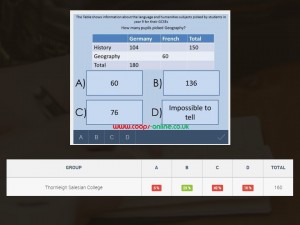What mistakes do students make when filling in data and interpreting information from a two way table?
It may be the half term holidays, but the Insight of the Week rolls on! Hundreds of schools and thousands of students around the country are now taking these weekly quizzes, and the insights that are coming from them are remarkable. It is those skills and those topics that we all assume our students can do which are cropping up as problem areas. And of course, it is exactly these sorts of questions that will cost our students valuable marks in the GCSE Maths Exam.
Many schools, including our own, are also setting these weekly quizzes for younger year groups, and that is great to see. Whilst the GCSE Maths exam may be changing, these essential skills will remain the same.
So, if you haven;t got invovled yet, now is the perfect time. Either pick up from these week, or go back to Week 1 start to see where all the fun began. It is completely free, and always will be.
Quiz 6 is below, followed by the key insight from this week.
How our students performed compared to the rest of the world:
Overall, our students did pretty well this week, and this could be taken as a sign that regular exposure to these key skills, followed up by analysis in departmental meetings and discussion with our students in class, is working. However, our students have one big problem area – two way tables!
Less than 30% of our students got this question correct, with option C tempting almost half of them.
I don’t know about you, but Two Way Tables is not a topic I spend a lot of time on in the classroom. It does not appear specifically anywhere on our schemes of work, and if I tend to cover it at all it is mainly just when I am going through exam papers with Year 11s. It is one of those topics I tend to assume my students can do – after all, two way tables are just common sense, right?
Well, if this question is anything to go by, apparently not. Our students have some interesting misconceptions when it comes both to completing two way tables and in interpreting them. Let’s take a closer look at these:
Incorrect Answer A (6% of our students chose this)
Not many students made the mistake of simply misreading the table (or maybe the question?), but enough did to make me want to cry. Imagine of they did this in the actual exam! Grrrr!!!!
“it says 60 in the table!”
Incorrect Answer C (49% of our students chose this)
Here is the answer that many of our students gravitated towards. This is not a misconception filling out the table, but one in correctly interpreting it. Was it because the students had not been exposed to enough of these to know how to read them, or were they simply careless? Their explanations are rather revealing:
“The table shows that 104 chose history and Germany leaving geography blanked but the total box says that the total sum is 180.To get from 104 to 180 you add 74”
“In total there were 180 people that chose history and geography. 180 (total) – 104 (history) = 76 (geography)”
“150-104=46, 46+60=106, 106+180=286, 286-150=136, 136-60=76”
Incorrect Answer D (16% of our students chose this)
This is an interesting one. Students belief that there was not enough information to answer the question may again suggest that they have not seen enough of these types of questions before and were thus put off by the gaps.
“It adds Germany to the table also so it has Germany and geography together so I will never know how many pupils picked geography”
“because too much information is missing from the table to work out the rest”
“It is impossible because it doesn’t show the total for geography”
The Correct Answer!
One of my motivations for developing Diagnostic Questions was so that students all around the world could learn from each other. When your students finish a quiz, please encourage them to review their answers, reading through other students’ explanations, until they find the magic one that makes sense to them. So, what are our Year 11 students’ favourite correct explanations to help them resolve their own misconceptions?
“180 – 104 is equal to 76, and we are told already that 60 students chose French and Geography meaning that 76 added to 60 is 136”
“because 180-104= 76 and the information already said there was already 60 people who chose geography so 60=76=136”
“180-104 = 76 76+60 = total =136”
Tackling the Misconception in Class
Now, with it being half term, there was no Monday night department meeting to discuss this question. However, I happen to be in Cambodia at the moment, launching Diagnostic Question with the Cambodian Ministry of Education, and my colleague is here with me. So, whilst she desperately tried to relax by the pool, cocktail in one hand, Candy Crush in the other, I managed to persuade her to help me think of a few suggestions to help tackle this problem:
- Obviously, ensure all students spend at least one full lesson on two way tables, completing them, interpreting them, and maybe even creating their own
- Always get the students to fill out the table in full, regardless of the question they are being ask
- Reinforce that they must check the totals add up correctly, both vertically and horizontally
- Circle or shade on the boxes which are relevant to answering the question
- Make sure students show working out to show how they have got the numbers in the table – this will often allow them to pick up valuable method marks if they make a daft mistake
- Expose students to the types of question where a two way table would be useful, but where one is not specifically provided for them
Please add any extra ideas in the Comments section below!
The series of GCSE Essential Skills Quizzes are available here and will always be completely free.
Quiz 6 is available here
I hope these quizzes will prove useful to help your students develop the essential skills necessary for success at GCSE, and aid your teachers gain a deeper understanding of how your students learn.


